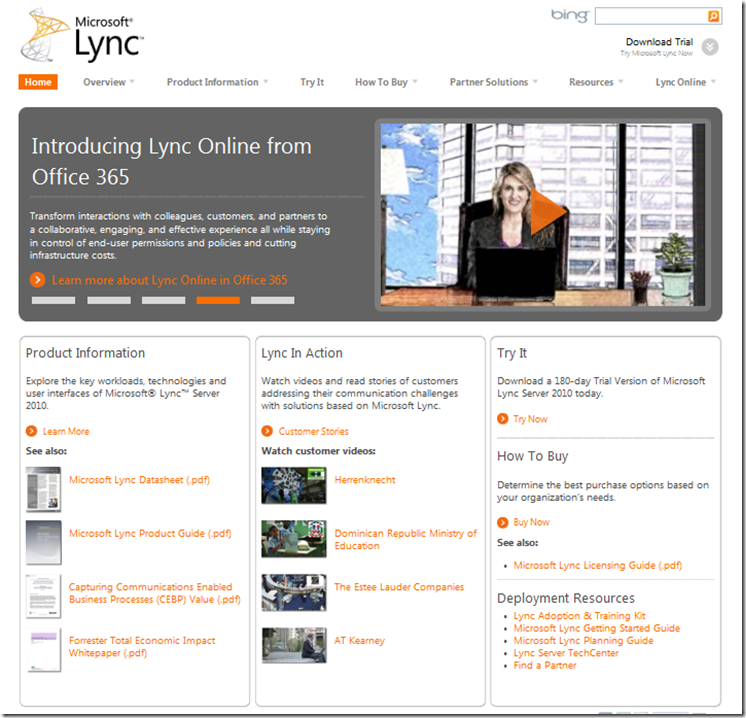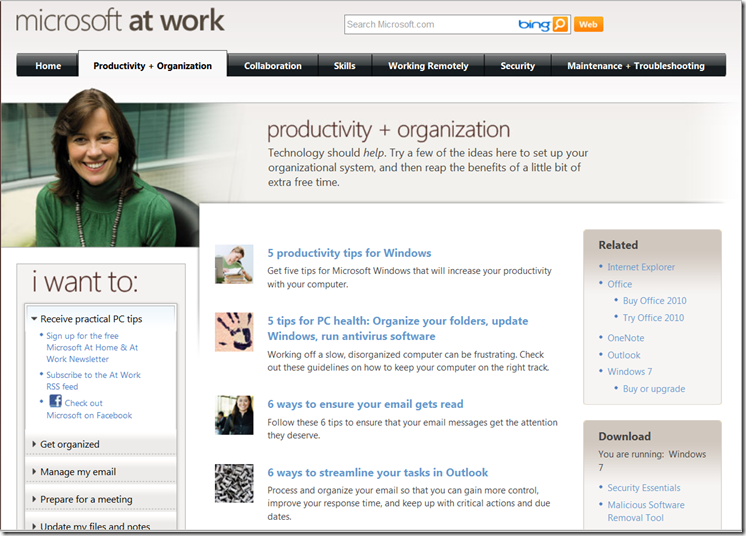The Unified Communications Customer Conversation for SMB, Part 1: Setting the Stage
My teammate JJ just did a great post on Lync (specifically Lync Online which you get with Office 365) where he pointed out, rightly so, that Lync is a game changer. I’ve just come off several weeks of training for one of our major distribution partners around Lync and helping them understand the value proposition for Unified Communications (UC) for small and medium businesses, which Lync is a big part of, and I thought I’d share that aspect as an extension to JJ’s post on Lync. As JJ said: “Don’t wait for your customers to ask you about it…. TELL THEM ABOUT IT!”, so in my next few posts I’m going to help you with some thoughts on how to do just that.
In Part 1 here, I’m going to lay some of the foundation for your discussion.
UC is part of what some call a “converged communication” approach (you might have heard Microsoft call this “Unified Communication and Collaboration, or UC&C)”. I ran across this short SMB-focused whitepaper on “Converged Communications: People and Applications in Synch” that I would recommend. One of the key points it makes is that “SMBs need powerful, location-independent converged communications and collaboration solutions to compete in today’s marketplace.“ It’s really all about productivity, and SMBs need that as much or more than larger organizations and, as you might have picked up from JJ’s post, UC can really enhance productivity, so that’s the conversation starter – productivity, they need it, you’re going to show them how get it.
Along the way, I'm going to use other references as well, including a Network World Whitepaper “Adopting Unified Communications Key Steps to Consider”, and whitepapers and other resources on Microsoft Lync Homepage which I’m highlighting in the screenshot below. Note: the Product Information section has a link to Forrester’s “Total Economic Impact” whitepaper which is a “composite case study” and incorporates feedback from real-world customers – I will also note, however, that this whitepaper is not SMB focused (but could still be useful). Notice also that the middle section includes videos and other customer ready resources that you might be able to leverage.
So the foundation of this customer conversation starts with the idea that we don’t focus specifically on UC as the starting point, but rather try to wrap it in the larger conversation of enhancing productivity. (And we do this to maximize the scope of the customer opportunity for you.) You should note that a 2011 CIO Magazine “State of the CIO” survey indicated that 2/3 of CIOs expect that improving work-force productivity will be the most significant IT task they focus on – the article states: “Heading into 2011, many CIOs are investing in projects to improve staff productivity, [and] make business processes more efficient.” Of course, as I mentioned above this isn’t just an issue for large businesses, you can bet that your SMB customer wants and needs improved work-force productivity as much as the bigger guys.
So what is productivity? Well you could just call it efficiency, which everyone also wants; but productivity kicks efficiency up a notch by incorporating the notion of enhancing business processes, as was alluded to above, on top of the efficiency angle which is basically just getting more done or getting something done in less time. And that’s why it’s important to be sure and help your customer understand that Collaboration is as integral a piece of the productivity story as UC is. This is a potentially critical distinction because the idea of deep integration across the range of UC&C components and is a key (and possibly unique) benefit you have with the Microsoft platform. So efficiency starts with having the best tools for your business – the right software really does make a difference, especially in today’s tough, competitive marketplace. Understanding what tools and technologies you can best leverage for specific tasks is key to boosting your productivity.
Productivity (for a business), in most cases, starts at the desktop. If your customer is still on older (we call it legacy) desktop technologies that are likely less secure and less efficient, then that would be a good place to start. In fact, if they don’t have a current desktop (e.g. Windows 7 and Office 2010), then they won’t be able to take full advantage of the latest server-side technologies such as Exchange 2010, SharePoint 2010, and Lync 2010, and even some of the basic server infrastructure stuff like Direct Access and Branch Cache. In fact, if they’re still on Office 2003, they won’t even have the option of leveraging Office 365. Consider using some of the resources at Microsoft at Work (see screenshot below) to help them see how getting on current technology can significantly impact efficiency and productivity and thus impact the bottom line. EVERY business does email now and if you haven’t given them a demo or discussion of how Exchange 2010 with Outlook 2010 can revolutionize their inbox management and save time every day then you’re missing an opportunity there.
In this same vein, here’s a link to something called Microsoft Productivity Hub (it’s on the Microsoft Download Center, so if this link doesn’t work for some reason, just search for it on Download Center). The Productivity Hub is a Microsoft SharePoint Server 2007 site collection that offers training materials for end-users, that you can download and put on your SharePoint site (you, and your customers, do have one of those I hope ![]() ).
).
And before I finish off this initial installment in this series, let me point out this CIO.com site: Innovations in Workplace Productivity, and let me also call out another link that you should definitely explore: The Future of Productivity Starts Here . I think you will find the Business Challenges part of this site informative and it will help you lay the foundation for the customer conversation by highlighting some of the major issues many of your customers are dealing with. But don’t forget to check out the “Our Solutions” and Why Microsoft” areas of that site as well, if you need more ideas or resources. The Why Microsoft section includes information on how Microsoft is an industry leader in most UC&C areas according to Gartner.
OK, so I think that should set the stage for you to start having a robust customer conversation around productivity, with a focus on UC (which is where started this odyssey). In Part 2 I will address the Unified Communication solution in general before we start to get into Lync specifically in Part 3.
Cheers,
Ron
![ronaldg-001_thumb1_thumb[1] ronaldg-001_thumb1_thumb[1]](https://msdntnarchive.blob.core.windows.net/media/TNBlogsFS/prod.evol.blogs.technet.com/CommunityServer.Blogs.Components.WeblogFiles/00/00/00/81/45/metablogapi/0871.ronaldg-001_thumb1_thumb1_thumb_63645152.jpg)

